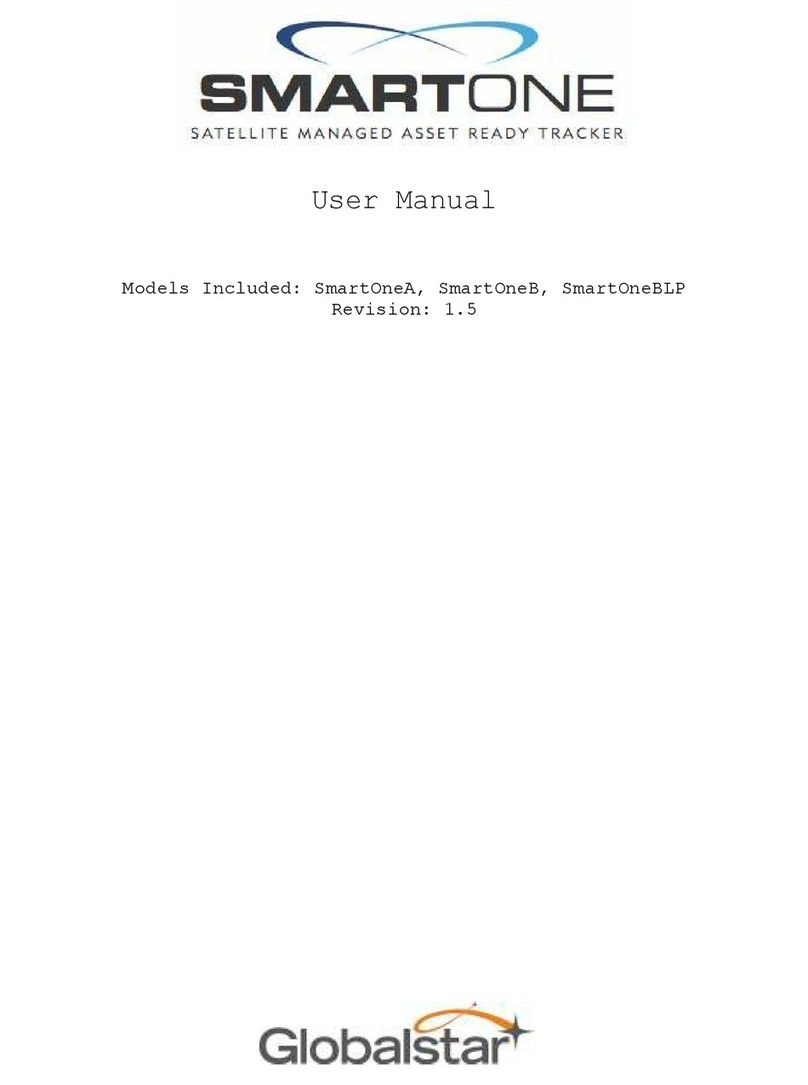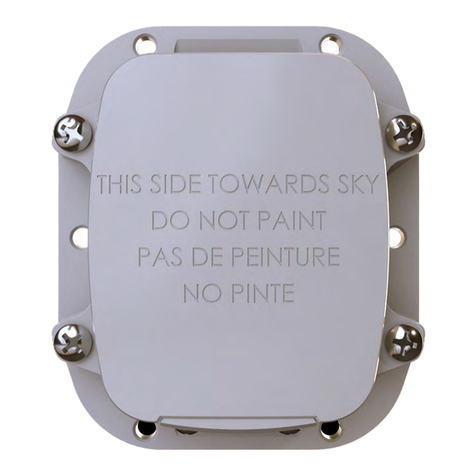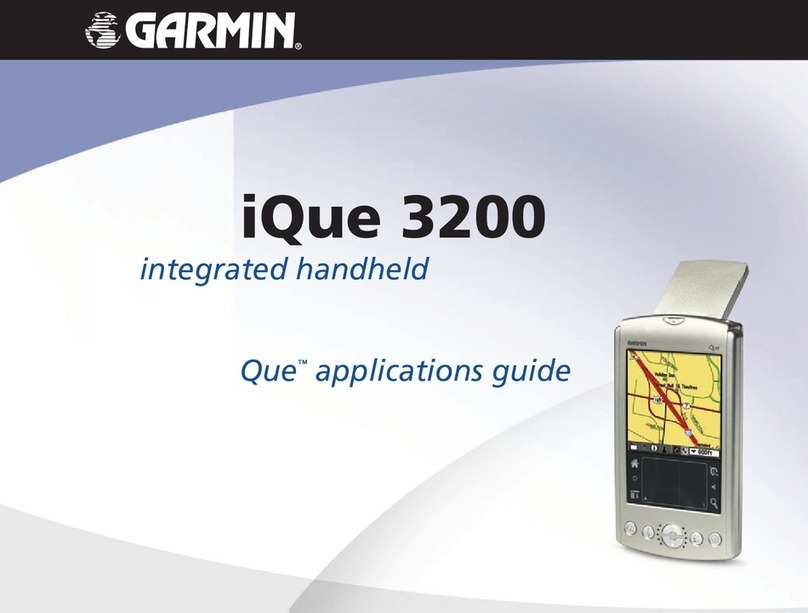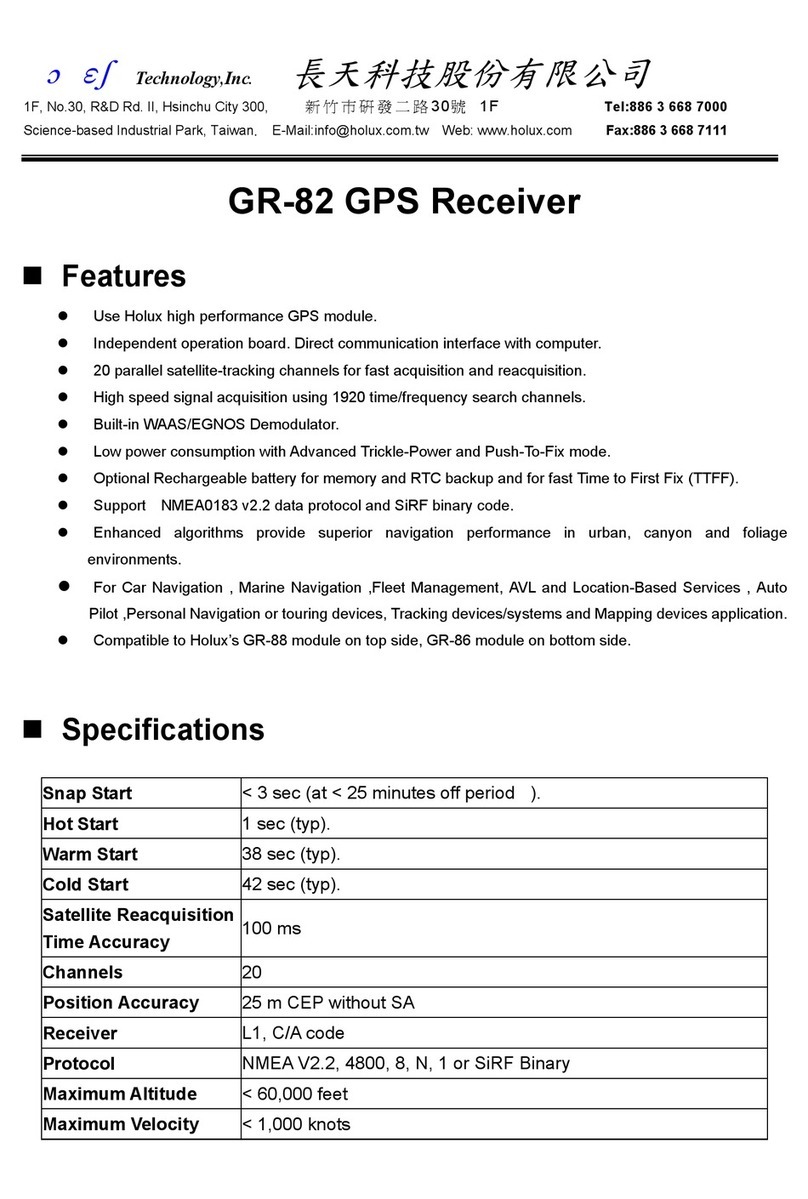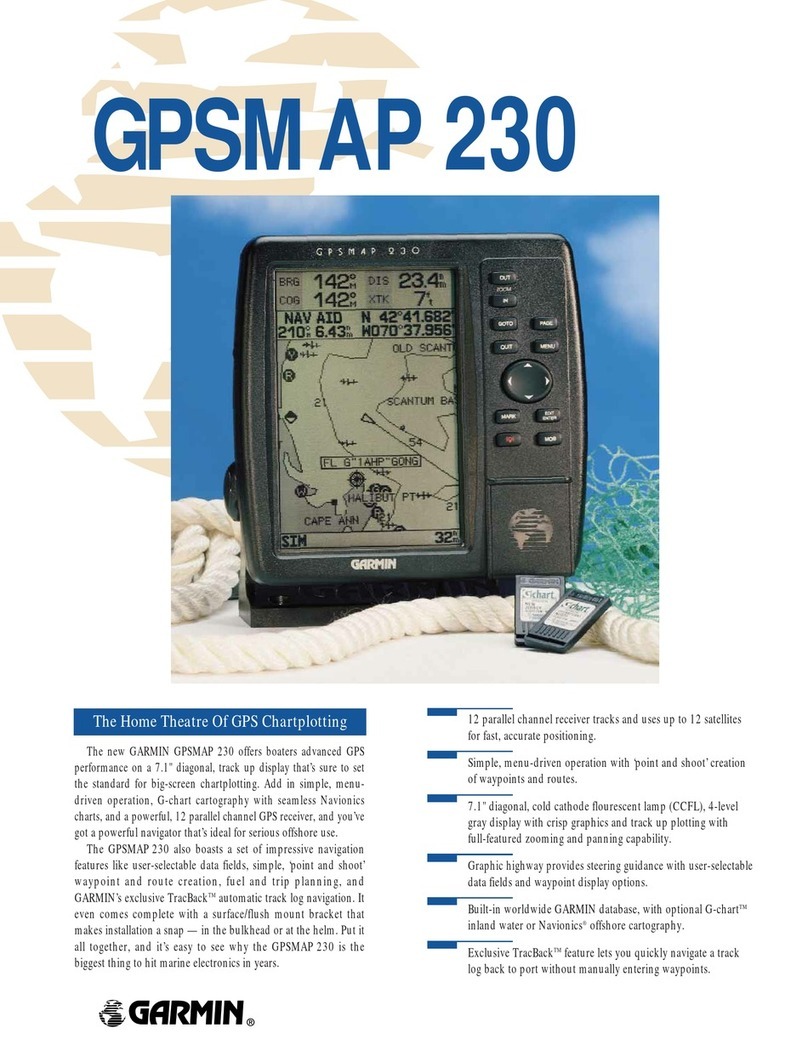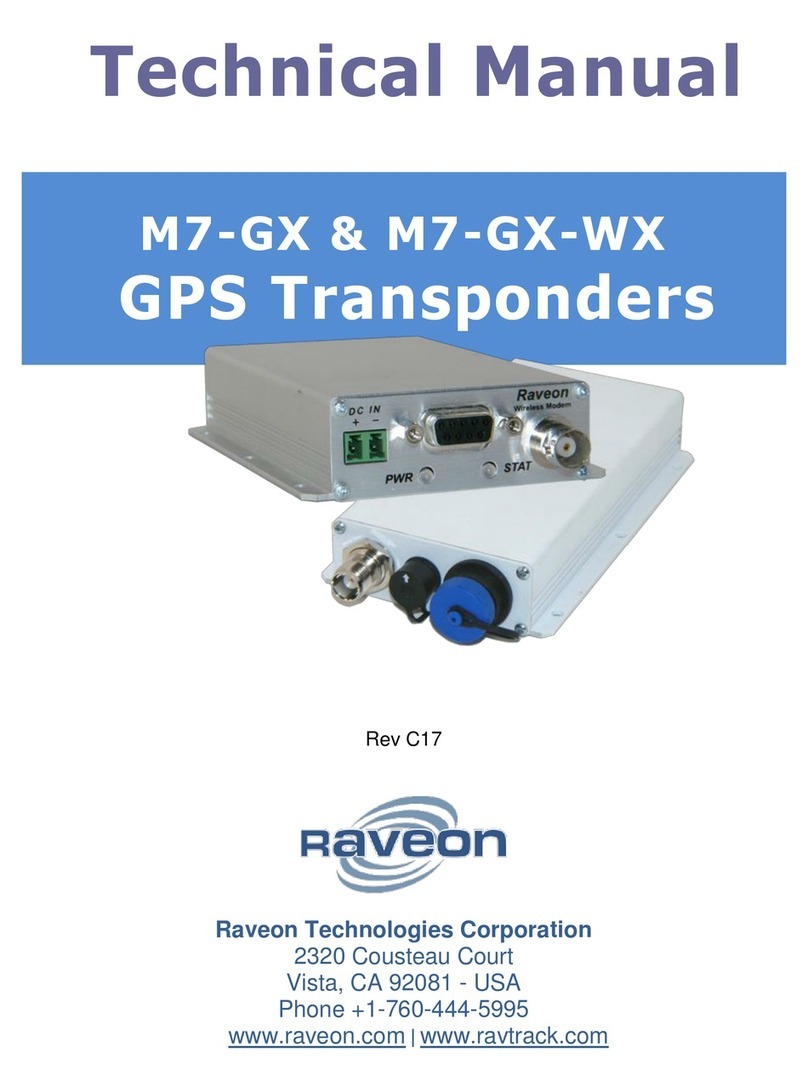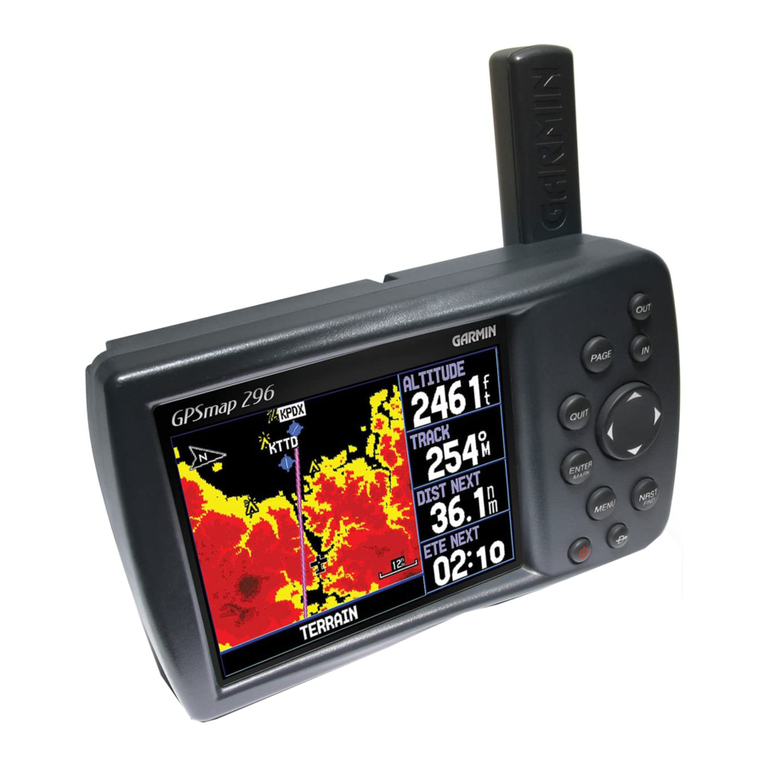Globalstar INTEGRITY 150 User manual

User Manual
INTEGRITY 150
9150-0126-01 R-2

Integrity 150 User Manual
Confidential & Proprietary Information
2
9150-0126-01 R-2
Distribution Statements
GLOBALSTAR CONFIDENTIAL AND PROPRIETARY INFORMATION – All data and information contained in this document are
confidential and proprietary to Globalstar, Inc. Information and instructions contained in this publication anticipate the user possesses
and applies the knowledge, training, and experience commensurate with requirements to meet prerequisite certification.
RESTRICTIVE EXPORT NOTICE – This document may contain technical data whose export is restricted by the Export Administration
Act of 1979, as amended, Title 50, U.S.C., App 2401 et seq. Violations of these export laws are subject to severe criminal penalties.
Disseminate only in accordance with such export laws.
DESTRUCTION NOTICE – Destroy by any method that will prevent disclosure of contents or reconstruction of the document.
Published and printed in the U.S.A. by:
Globalstar, Inc.
1351 Holiday Square Blvd.
Covington, LA 70433
Copyright ©2022 Globalstar, Inc. All rights reserved.
Globalstar® is a registered trademark of Globalstar, Inc. All other brands, product name, trademarks and registered trademarks are
properties of their respective owners. This material may not be reprinted, republished, broadcast, or otherwise altered without the
publisher’s written permission. This manual is provided without express, statutory, or implied warranties. The publisher will not be held
liable for any damages caused by or alleged to be caused by use, misuse, abuse, or misinterpretation of the contents.
Content is subject to change without notice.
Revision date: 05/19/2022

Integrity 150 User Manual
Confidential & Proprietary Information
3
9150-0126-01 R-2
Contents
INTEGRITY 150 BASICS
................................................................................................................................4
OVERVIEW...........................................................................................................................................................................4
MODES OF OPERATION
....................................................................................................................................................4
STANDARD MESSAGING
...................................................................................................................................................4
SOLAR PRODUCT PRECAUTIONS....................................................................................................................................6
BLUETOOTH INTERFACE...................................................................................................................................................6
SATELLITE COMMUNICATIONS.........................................................................................................................................7
GLOBALSTAR SATELLITE NETWORK...............................................................................................................................8
GETTING
STARTED
.......................................................................................................................................9
THE Integrity 150 DEVICE....................................................................................................................................................9
BATTERY PACK
................................................................................................................................................................9
TURNING ON AND OFF
....................................................................................................................................................9
COMMISSIONING ...........................................................................................................................................................9
INSTALLATION................................................................................................................................................................9
MOUNTING METHODS
...............................................................................................................................................................10
ST CONFIGURATION
...................................................................................................................................11
MESSAGES
............................................................................................................................................11
GLOBAL MESSAGE TYPE............................................................................................................................................11
APPENDIX A – GLOSSARY OF TERMS
..........................................................................................................12
APPENDIX B – TECHNICAL SUPPORT
..........................................................................................................15
APPENDIX C – RF RADIATION EXPOSURE STATEMENT
....................................................................................16
APPENDIX D – REGULATORY NOTICES
.........................................................................................................17
APPENDIX E – GENERAL WARNINGS
...........................................................................................................20
APPENDIX F – SPECIFICATIONS & STANDARDS
............................................................................................21
APPENDIX G – DEVICE POWERED LIMITATIONS
.............................................................................................22
TYPICAL USAGE LIFE
.....................................................................................................................................................22

Integrity 150 User Manual
Confidential & Proprietary Information
4
9150-0126-01 R-2
INTEGRITY 150 BASICS
OVERVIEW
The Integrity 150 is Globalstar’s next-generation solar-powered satellite tracking and smart data
management device. Engineered with open-source common architecture, the Integrity 150 offers
a simplified design with the newest hardware and software capabilities and an abundant amount
of storage to support the most demanding development requirements.
The core functionality of the Integrity 150 is to process GPS satellite signals to obtain its position in
terms of longitude & latitude and transmit this information over Globalstar’s Satellite Network via a
maintenance free, self-charging solar device. In addition to the standard capabilities found in most
Globalstar tracking products, the Integrity 150 has fixed or interval location reporting, change of
location and motion alerts, reduced messaging and theft alert, and raw payloads.
The Integrity 150
can be configured for your custom applications assuring that your critical information is captured and
transmitted over the Globalstar network. Using built-in components, or external BLE sensors, allows
ultimate control of the information you need to meet your specific needs.
The Integrity 150 is configured via a profile over the Bluetooth® interface. The profile contains all the
configurable parameters needed to perform the desired functions that compose the transmitted
messages. The profiles can be created and edited via the Globalstar portal.
MODES OF OPERATION
The Integrity 150 can be configured to operate in one of four different tracking modes:
•
Standard Messaging
•
Reduced Messaging (Change of Location)
•
Theft Alert
•
Geofence
STANDARD MESSAGING
In Standard Messaging Mode, the Integrity 150 reports its position at regular time intervals that are programmed during the
configuration process. Standard Messaging Mode can also be configured to utilize the Integrity 150’s internal
motion/vibration sensor. If enabled, the Integrity 150 will transmit its position at independently configured regular time intervals
when
the device is In Motion.
Location messages can be programmed to be constant (Interval Messaging) or the device may be configured to send messages at
specific times up to 10 different intervals in sequence (Time(s) of Day Messaging). Message intervals can range from 35 minutes to 45
days, with one-minute resolution.
•
Example of Message Interval:
The Integrity 150 is configured to report once every 24 hours when not In Motion and every
two hours when In Motion. If the Integrity 150 went into motion at any time of day the Message Interval while In Motion would
be every two hours beginning when the Integrity 150 started moving.

Integrity 150 User Manual
Confidential & Proprietary Information
5
9150-0126-01 R-2
•
Example of Message-Time(s) of Day:
The Integrity 150 is configured with a message time of day of 9:00 AM, a second message
time of day of 12:00 noon, a third message time of day of 8:00 PM and once per hour when In Motion. The Integrity 150 would
transmit three messages a day at the same configured times every day. If the Integrity 150 went In Motion, it would transmit its
location message every hour.
•
Usage Example:
A Company is required to report the GPS locations of their hazardous chemical containers twice a day. Based
on this requirement, the Company has two options: set a message interval of every 12 hours (the 12 hour internal begins when
the device is powered up) or when the configure message times of day are 12:00 noon and 12:00 midnight.
CHANGE OF LOCATION (REDUCED MESSAGING)
Change of Location Mode allows for devices to be monitored less aggressively when they remain at the same location. Messages are sent
at a minimal message interval when the asset is in a defined area and transmits at a higher message interval when the asset is changing
locations. These message intervals are set as part of the configuration process based on the concept that repeated reporting information of
the same location, when an asset has not moved from its defined area, is redundant and doesn’t provide additional usable information
about its current location.
By comparing current and prior position information, the Integrity 150 determines if its location is changing. The definable area in which the
device should remain in Reduced Messaging Mode at rest is called the Change of Location Area and is a circle (100 meters by default).
When the Integrity 150 goes outside of the circle, in motion, its location is considered to be changing or relocating. Once a device has two
consecutive track points that indicate it has remained in the radius of the configured circle, it will re-center the change of location to its
current location and resume transmitting at the “at rest” rate.
•
Usage Example:
A fleet operator owns 1,000 trailers. When the trailer(s) are sitting at a depot they want a location message once
a day. They also want a message notification within one hour when a trailer has left a depot. Lastly, they want a location message
every three hours when a trailer is moving between depots. Based on this requirement, the fleet operator will need to set the
Change of Location Area (size of the depots where the trailers will visit), the message interval while the trailers are inside the
Change of Location Area (one per day), the interval at which the Integrity 150 will check its location while in a State of Vibration
and inside the Change of Location Area (one per hour), set the number of messages when the trailer leaves the Change of
Location Area (one Change of Location Area Alert Message) and the message interval while the trailers are in transit between
depots (every three hours).
THEFT ALERT
When the Integrity 150 is configured to operate in the Theft Alert Mode, it differentiates between authorized and unauthorized movement of
an asset. When the Integrity 150 obtains a position from GPS satellites, the position is used to set the center of the defined Change of
Location Area in Theft Alert Mode. While the Integrity 150 is at rest within the defined radius, by default 100 meters, all movement of the
asset is considered authorized. Once the Integrity 150’s position is outside of the Change of Location Area, it alerts as an unauthorized
movement and immediately sends a location message (Change of Location Alert Message). The Integrity 150 continues to send location
messages at a message interval set during the configuration process until the power is turned off or the battery is dead.
•
Usage Example
: A construction company is working on a job site for one year and wants to ensure that their generators and
other heavy equipment on site aren’t stolen. The company wants to check the location of their equipment 12 times a day, every 2
hours, to confirm the asset hasn’t been stolen, but only wants a transmitted location message once per day. Based on this
requirement, the construction company will need to set the Change of Location Area (size of the job site), the message interval
while inside the Change of Location Area (one per day), the interval at which the Integrity 150 will check its location while in a
State of Vibration and within the Change of Location Area (every two hours) and the message interval if the asset is outside the
Change of Location Area.

Integrity 150 User Manual
Confidential & Proprietary Information
6
9150-0126-01 R-2
GEOFENCE
To operate the Integrity 150 with a Geofence, the size, shape, and location of the area is defined in its configuration. While the unit remains
in the defined area, it will transmit its location at the at rest rate. When the unit is moved outside the defined Geofence area, the unit will
transmit at the in-motion rate. The unit will continue to transmit at the in-motion rate until it returns to the defined Geofence area. Once back
in the Geofence, the unit will transmit at the at rest rate.
•
Usage Example:
A rental equipment company needs to monitor assets as they leave the property until they return. The company
needs to know what is on the property twice a day. Once an asset has been rented, the company wants to know its location every
hour. This allows them to monitor how far they are travelling as well as if it is lost or stolen.
SOLAR PRODUCT PRECAUTIONS
The Integrity 150 uses a built-in solar panel to recharge its internal batteries. To maximize the recharging capability of the Integrity 150 it is
important to keep in mind the following:
• The clear plastic above the solar panel on the Integrity 150 should be kept clean and free of soil, paint, or debris to maximize battery
charging capability.
• Solar panels produce the most electricity when they are perpendicular to the sun.
• Shading and weather conditions may negatively affect the charging of the batteries from the solar panels.
• If the batteries of the Integrity 150 are depleted, it is recommended to allow the Integrity 150 to receive a full day (6+ hours) of adequate
sunlight to fully charge the batteries.
• If the clear plastic panel covering the solar panel becomes cracked, the Integrity 150 should be replaced.
BLUETOOTH INTERFACE
The Integrity 150 uses its built-in Bluetooth interface to advertise itself and for programming configuration settings as well as updating
firmware. The ST Configuration Software may be used to read and/or alter the Integrity 150’s programmed configuration. The method to
perform this function is described in the ST Configuration Software section.
The Integrity 150 may also be configured to advertise its specific data, such as its UID and Firmware Version, over its Bluetooth interface.
This periodic advertisement allows a user to use a Bluetooth scanning program to read the advertisement data generated by the Integrity
150. Globalstar does not supply nor support any Bluetooth scanning programs.
For detailed protocol of the Bluetooth advertisement please refer to the 8550-0004-01 Globalstar ST150 BLE Reference Guide . This
manual may be found on the Globalstar Partner Support website
https://partner.globalstar.com.
Further details of the Bluetooth Sensors can be obtained in the 8550-0008-01 Globalstar SmartOne Sensors BLE Specification.This
manual may be found on the Globalstar Partner Support website at
https://partner.globalstar.com.

Integrity 150 User Manual
Confidential & Proprietary Information
7
9150-0126-01 R-2
SATELLITE COMMUNICATIONS
The Integrity 150 communicates with both the GPS satellite network and the Globalstar Satellite Network. All GPS locations
are pulled from the GPS network and all transmissions are sent via the Globalstar Satellite Network.
The Integrity 150 has the unique ability to check its GPS coordinates at a programmable rate while it is inside of the Change
of Location Area without
sending
a message over the Globalstar Satellite Network.
For a Location Message, the Integrity 150 will wake up at a scheduled interval or time of day and begin to acquire a GPS fix.
Once it receives its GPS fix, the Integrity 150 will transmit its location to the Globalstar Satellite Network.

Integrity 150 User Manual
Confidential & Proprietary Information
8
9150-0126-01 R-2
GLOBALSTAR SATELLITE NETWORK
The Globalstar Satellite Network consists of Low Earth Orbiting (LEO) satellites that are
constantly orbiting the earth and each satellite completes its orbit in less than two hours.
Because of this, the Integrity 150 will be in contact with at least one of the satellites during
each scheduled transmission.
In LEO communication networks, the satellites are constantly changing their positions in
the sky relative to the transmitter on earth. This minimizes the shading effects seen in
geostationary satellite systems where the mobile device must be pointed toward a specific
direction in the sky. Geostationary satellites also orbit at a much higher altitude and move
along the equator.
Messages are transmitted from the Integrity 150 via the Globalstar Satellite Network using
an uplink-only connection (one-way data transmission) and received by a Globalstar Ground Station. The messages are then sent via an HTTP,
HTTPS, or FTP server to
the internet and received by the customer’s back-office application and converted into actionable data.

Integrity 150 User Manual
Confidential & Proprietary Information
9
9150-0126-01 R-2
GETTING
STARTED
THE Integrity 150 DEVICE
BATTERY PACK
The Integrity 150 is powered by an internal Lithium-ion (Li-ion) battery pack. The battery pack is not accessible to the user and
is not replaceable. The Integrity 150 is designed for the solar panels to
recharge
the battery pack.
A user may realize up to 10 years of maintenance-free operation based on adequate sun exposure to recharge the battery
pack.
TURNING ON AND OFF
The
Integrity 150
ships
powered off in an opaque container
.
Once the solar panel is exposed to sufficient light, the unit will power
on. A flashlight or the camera light on a mobile device is sufficient to turn on an Integrity 150. Upon
initial power up, the unit will
go into a Factory Power State. In this state the unit will behave just as it is in a normal mode except that it will automatically
enter the full off state if there has been no solar input for 4 hours. Once a configuration profile is applied to the Integrity 150 via
the mobile application, it will follow its power management state to normal operation and will never enter the Factory power
mode again.
Once a unit has been configured by applying a profile from the mobile application, it will remain on indefinitely. The unit can be
turned off through the mobile app via the “Power Off” button found at the top of the Scan screen. If storage is necessary, it
should be packaged in an opaque container and powered off.
The r
ecommended storage temperature is
ideally
between
-40
º
C and 85
º
C. The shelf life of the Integrity 150 is
1 year
and the maximum storage period is
5 years
.
COMMISSIONING
Before installing the Integrity 150, record the Unique Identifier (UID) and identify the asset to which it will be mounted. The UID
is etched on the top mounting surface of the Integrity 150, such that it will be visible after installation. There is also a bar code
that contains the UID on the device.
INSTALLATION
The
Integrity 150
must be mounted on the asset with a clear view of the sun and sky. The device requires a minimum flat surface area
of 24.4
cm x 8.61 cm (10.39” x 3.38”). The ideal configuration is facing up on a flat horizontal surface.
The
Integrity 150
can also be mounted on a flat vertical
surface
but this may reduce the communication reliability, decrease the maximum
sustainable messaging rate, affect the charging capability of the device, and may reduce the GPS location
accuracy. If the device must be
mounted vertically, it is recommended to point the device with the solar panel end upward towards the sky. This allows the
messages to be transmitted best in a vertical mount application as the batteries are located opposite the Solar panel which
reduces internal obstructions.

Integrity 150 User Manual
Confidential & Proprietary Information
10
9150-0126-01 R-2
MOUNTING METHODS
Use the following recommended procedures to mount the Integrity 150.
Mounting with the VHB tape
:
The VHB tape is provided along with the Integrity 150 device. Please clean and dry the flat mounting surface before installation.
a. Peel off the protective cover from one side of the VHB tape. Please pay attention to the orientation of the tape to match the device orientation.
Stick the VHB tape to the cleaned surface and gently press it to ensure it stays secure.
b. Peel off the protective cover from the other side of the VHB tape.
c. Stick the magnetic puck assembly to the VHB tape dedicated circular cutout. Please make sure the magnetic side is facing up and the puck
stays within the cutout.
d. Stick the Integrity 150 device to the VHB tape and gently press it down to ensure it stays secure.
Mounting with the stainless-steel sled (Optional):
The stainless-steel sled must be ordered separately from Globalstar.
A. The stainless-steel plate has four reserved mounting holes for customers’ needs. The hole patterns and size are shown below in
Figure 1, Mounting Plate Hole Pattern and Dimensions. Mount the stainless-steel sled to the asset with four screws of customer's
choice. The customer can choose their own screws to meet the mounting hole specs on the asset.
NOTE:
The customer mounting screw head needs to be under the diameter of 9.3 mm (0.366”) and under the height of 3.0 mm (0.118”).
Figure 1: Mounting Plate Hole Pattern and Dimensions

Integrity 150 User Manual
Confidential & Proprietary Information
11
9150-0126-01 R-2
B. Put the magnetic puck assembly to the stainless-steel sled dedicated circular cutout in the center of the plate, making sure the
magnetic side is facing up.
C. Install the Integrity 150 device to the sled using the four M4x12 screws that are provided with the sled. Hand tighten the screws
with a 3 mm hex Allen key. Please do not overtighten the screws.
ST CONFIGURATION
The Integrity 150 can be configured via the My IoTAccount Portal for general features. The application is primarily used to sync profiles from the
back office into the application so that they can be applied to a unit.
Refer to 9150-0127-01 Globalstar ST Configuration App User Manual for detailed examples of firmware updating and management of your devices.
MESSAGES
The Integrity 150 produces on-air messages conforming to the Globalstar specified format. Refer to 8550-0002-01 Globalstar Unified API
document for detailed examples of various message decoding.
The data being communicated to the end user is contained entirely in the 72-bit (9-byte) field. This section will describe the use of the 9-byte
user information segment for communicating the range of information that the Integrity 150 is able to convey to the user.
NOTE:
User information is also referred to as the Message Payload.
GLOBAL MESSAGE TYPE
Bits 0 and 1 in the first byte of the user data defines the Global Message Type; there are four total global types. Types 0 and 3 are applicable
to the function and features of the Integrity 150, Type 1 and 2 are user defined message types.
• Type 0 - Standard Message: All the various message types that contain Latitude and Longitude data that are transmitted
by the Integrity 150 will be of this type.
• Type 1 - Truncated Message: This message type provides for up to 2 bytes plus 6 bits of user data to be appended to the
status byte and GPS location information.
• Type 2 - Raw Message: This message type provides for up to 8 bytes plus 6 bits of user data.
• Type 3 - Non-Standard Message: The Integrity 150 will use this message type for modular messages, as well as health
check message. The modular messages are recommended for new designs. Legacy message sub types include
Accumulate/Count messages, Contact Service Provider messages and Low Battery messages.
Globalstar messages can send up to 144 bytes of data per transmission, broken into 9-byte packets. Transmissions can consist of up to 16 9-byte
packets sent sequentially. The packet is the lowest discreet data element that can be sent. Messages that do not utilize the max possible length will
be automatically interleaved with other messages in the transmit queue, for better through put and lower latency.
Interleaving example: M1 is a 9-byte message queued for dispatch. By default, every message is retried 2 times. M2 is queued for dispatch after
M1 has initially been transmitted. Review below how messages will be transmitted based on defined retry intervals:
At T0, M1 transmitted
At T1, M2 transmitted, M1 first retry
At T2, M2 first retry, M1 second retry
At T3, M2 second retry
At T4, no transmission, queue is empty
Up to ten 9-byte messages can be sent in a transmission.

Integrity 150 User Manual
Confidential & Proprietary Information
12
9150-0126-01 R-2
APPENDIX A – GLOSSARY OF TERMS
A
Accelerometer –
A sensor used for detecting and measuring vibration.
Accumulate Hours –
The activity time accumulated in the Inputs of the device while the Input is in the user defined state.
Activation –
The activation of a UID (Unique Identifier) on the Globalstar satellite network. The process consists of programming a start and an
end date for the use of the UID and the payment of certain fees to Globalstar. Sometimes referred to as “provisioning.”
At Rest –
A tracker is considered to be at rest when the comparison of a new GPS reading to a previous GPS reading indicates the tracker has
not changed location by more than a specified minimum distance. The specified minimum time and the specified minimum distance are both
configuration parameters.
C
Configuration –
The collection of variables that control the operating performance of a device.
Configure (configuring) –
Programming (setting) the variables that control the operation performance of a tracker.
Count Events –
The accumulated number of state changes in the Inputs of the device.
D
Delay to Start –
Specific delay in time following the programming of the device to commence operation.
Desired State –
The state of the Input in normal condition defined by the user.
E
ESN –
Electronic Serial Number is a unique number assigned to each Integrity 150. The ESN is used by Globalstar Satellite Networkto
identifymessagesfrom thedevicesin thefield.
F
Failed GPS reading –
A GPS reading could not be processed from available GPS satellite signals.
FW Ver –
Firmware version is the existing software loaded in the device main processor.
G
GPS –
The GPS (Global Positioning System) is a "constellation" of 24 well-spaced satellites that orbit the Earth and make it possible for
people with ground receivers to pinpoint their geographic location.
GPS reading –
The longitude, latitude, time, and date information obtained from processing the signals from the GPS satellites.

9150-0126-01 R-2
Integrity 150 User Manual
Confidential & Proprietary Information
13
I
In Motion –
The unit is considered to be In Motion when there is a State of Vibration – and – the accelerometer status indicates there is motion.
Inaccurate GPS Reading –
The longitude and latitude information obtained from processing the signals from the GPS satellites when a tracker
cannot observe an adequate number of satellites; the GPS signals were jammed by electronic interference; the GPS signals were reflected
from objects creating multi-path conditions; or weather conditions distorted the GPS signals. An inaccurate GPS reading may have longitude
and latitude errors of a mile or more.
Input –
Mapped events in the Integrity 150 that monitors state changes. The Tamper switch is the only physical device input, ON/ OFF.
M
Message –
A collection of information that is transmitted in a group over the satellite network.
Message Interval –
The message interval indicates the amount of time specified by the user between Location Messages.
The Integrity 150 transmits a Location Message once the Message Interval has elapsed. The internal clock on the device is reset to the
interval time after each transmission. The Integrity 150 is in low power consumption mode during the interval to preserve battery life.
Message Time(s) of Day –
The specific time of day in military format for the Integrity 150 to transmit Location Messages. The Integrity 150 is in
low power consumption mode between the specific times of day to preserve battery life.
Message Transmission –
The process of sending a message over the satellite network. This includes sending a message multiple times to
improve the transmission success rate.
N
Number of message repeats –
The number of times a message is sent for a message transmitted with the same Unique Message Number (UMN).
The number of message repeats is configurable during the tracker set up process. Globalstar only counts repeated messages as one message
if it is received three times or less. If the same message is received more than three times, Globalstar may count the message as more than
one message for billing purposes.
P
PV –
Photovoltaic cells; the name of the cells contained in the Device panel.
S
Self Test –
An internal unit test that is performed by the processor, checking for the proper operation of unit functions.
State of Lacking Vibration (SOLV) –
The motion sensor is indicating a cease of vibration when the number of vibration pulses per minute is
lower than the Level of Sensitivity for Vibration Sensor number for the time required to determine if a State of Vibration has ceased. The
motion sensor is indicating that the vibration pulses per minute is lower than the Level of Sensitivity for Vibration Sensor for the configured
period of time.
State of Vibration (SOV) –
The motion sensor is triggered when the number of vibration pulses per minute is above the Level of Sensitivity for
Vibration Sensor. The motion sensor is triggered when the vibration pulses per minute is above the Level of Sensitivity for Vibration Sensor for
the configured period of time.

9150-0126-01 R-2
Integrity 150 User Manual
Confidential & Proprietary Information
14
T
Time to be in a State of Lacking Vibration –
A configurable parameter that sets the period of time vibration has to be absent to determine if a State of
Vibration has ceased.
Time to be in a State of Vibration –
A configurable parameter that sets the period of time used to determine if a State of Vibration exists.
U
Undesired State Message –
The Integrity 150 sends this message at a user defined interval while any of its Inputs are in the undesired state
selected by the user, either closed or opened.

Integrity 150 User Manual
Confidential & Proprietary Information
15
9150-0126-01 R-2
APPENDIX B – TECHNICAL SUPPORT
We suggest VARs and Partners reference our online content at our Globalstar Partners Support website,
https://partner.globalstar.com. This content should address most activation/provisioning inquiries and frequently asked
questions concerning business account management functions.
For VARs, please create an account by accessing the Globalstar Partners Support website and clicking on Sign
Up For Access at the bottom of the page
.
For all other support issues, please contact Globalstar, Inc. at our corporate headquarters:
Email: varsupport@globalstar.com
Phone:
1 (877) 452-5782 or 1 (985) 327-7500
Address:
Globalstar, Inc.
1351 Holiday Square Blvd.
Covington, LA 70433

Integrity 150 User Manual
Confidential & Proprietary Information
16
9150-0126-01 R-2
APPENDIX C – RF RADIATION EXPOSURE STATEMENT
This equipment complies with FCC radiation exposure limits set forth for an uncontrolled environment. End users must follow the specific
operating instructions for satisfying RF exposure compliance. The antenna(s) used for this transmitter must be installed to provide a separation
distance of at least 20 cm from all persons and must not be co-located or operating in conjunction with any other antenna or transmitter.
NOTE:
The Integrity 150 antenna is located under the embossed label that states “This side towards sky.”
RAPPORT D'EXPOSITION DE RAYONNEMENT DE LA FCC RF Cet equipment est conforme aux limites d'exposition de rayonnement de la
FCC RF determinees pour un environnement non controle. Cet equipment devrait etre installe et actionneavec une distance minimumde 20
cm entre le radiature et votre corps.

Integrity 150 User Manual
Confidential & Proprietary Information
17
9150-0126-01 R-2
APPENDIX D – REGULATORY NOTICES
FCC/IC NOTICES
This device complies with Part 15 of the FCC Rules. Contains FCC ID: L2V-ST150M. Contains IC ID: 3989A-ST150M. Operation is subject to
the following two conditions:
(1) this device may not cause harmful interference, and (2) this device must accept any interference received, including interference that may
cause undesired operation. Changes or modifications not expressly approved by the party responsible for compliance could void the user's
authority to operate the equipment.
NOTE:
This equipment has been tested and found to comply with the limits for a Class B digital device, pursuant to part 15 of the FCC
Rules. These limits are designed to provide reasonable protection against harmful interference in a residential installation. This equipment
generates, uses and can radiate radio frequency energy and, if not installed and used in accordance with the instructions, may cause
harmful interference to radio communications. However, there is no guarantee that interference will not occur in a particular installation. If
this equipment does cause harmful interference to radio or television reception, which can be determined by turning the equipment off and
on, the user is encouraged to try to correct the interference by one or more of the following measures:
•
Reorient or relocate the receiving antenna.
•
Increase the separation between the equipment and receiver.
•
Connect the equipment into an outlet on a circuit different from that to which the receiver is connected.
•
Consult the dealer or an experienced radio/TV technician for help.
This device complies with Industry Canada’s license-exempt RSSs. Operation is subject to the following two conditions: (1) This device may
not cause interference; and (2) This device must accept any interference, including interference that may cause undesired operation of the
device.
Le présent appareil est conforme aux CNR d'Industrie Canada applicables aux appareils radio exempts de licence. L'exploitation est autorisée
aux deux conditions suivantes : (1) l'appareil ne doit pas produire de brouillage, et (2) l'utilisateur de l'appareil doit accepter tout brouillage
radioélectrique subi, même si le brouillage est susceptible d'en compromettre le fonctionnement.
CAN ICES-3 (B)/NMB-3(B) – This Class B Digital Apparatus Complies with Canadian ICES-003.
Cet Appareil numerique de la classe (B) est conforme a la norme NMB-003 du Canada.
This device complies with the requirements for Radio Astronomy Site avoidance as specified by the Globalstar National Science
Foundation agreement of 2001. It is compliant with CFR25.213.
This device automatically adjusts its transmission frequency according to its location and is compliant with international regulatory
requirements.

Integrity 150 User Manual
Confidential & Proprietary Information
18
9150-0126-01 R-2
CE NOTICES
DECLARAT ION OF CONFORMITY FOR EUROPEAN CUSTOMERS
Hereby, Globalstar declares that this Integrity 150 is in compliance with the essential requirements and other relevant provisions of
Directive 2014/53/EU.
The declaration of conformity may be consulted at Globalstar.com/Regulatory.
Integrity 150™ Transmit Frequencies: 1611.25 Mhz - 1618.75 Mhz (4 Channels)
Integrity 150™ Max Power Out: 23.50dBm EIRP
Integrity 150™ Rated Voltage and Rated Maximum Current: Batteries are rated 4.1 V, 400 mA discharge and 240 mA charge.
The Integrity 150 has been so constructed that the product complies with the requirement of Article 10(2) as it can be operated in at least
one Member State as examined and the product is compliant with Article 10(10) as it has no restrictions onbeing put into service in all of the
EU except Ireland. The Integrity 150 cannot be marketed in Ireland
.
Not to be Marketed in the Republic of Ireland
Anatel Certification stamp for operation in Brazil:
Portuguese
Produto não acabado, de uso interno, cuja integração em outros equipamentos pode
requerer nova certificação
Este equipamento não tem direito à proteção contra interferência prejudicial e não
pode causar interferência em sistemas devidamente autorizados.
English
Unfinished product, for internal use, the integration of which into other equipment may
require
further certification.
This equipment is not entitled to protection against harmful interference and may
not cause interference to properly authorized systems.
Australia/New Zealand RCM:

Integrity 150 User Manual
Confidential & Proprietary Information
19
9150-0126-01 R-2

Integrity 150 User Manual
Confidential & Proprietary Information
20
9150-0126-01 R-2
APPENDIX E – GENERAL WARNINGS
Warning - Modifications:
Changes or modifications not expressly approved by the party responsible for compliance could void
the user's authority to operate the equipment.
Warning – Driving:
Always follow safe driving practices and local rules and regulations regarding the use of wireless devices
while driving. Do not drive when programming or servicing the Integrity 150.
Warning - Installation and Service:
Allow only authorized personnel to install or service the Integrity 150 and accessories.
Faulty installation or service can be dangerous and can void the warranty.
Warning – Mounting:
Using any other mounting bracket than the optional metal mounting bracket to secure the Integrity 150
will void all warranties and Intrinsically Safe certifications.
Warning - Pacemakers:
The Health Industry Manufacturers Association (HIMA USA) recommends that a minimum
separation of six (6”) inches be maintained between the Integrity 150 and a pacemaker to avoid potential interference with
the pacemaker.
Warning – Tightening Cover Screws:
Upon replacing the Configuration Cable Cover, tighten the screws according to specification
(Section 2 of this manual); otherwise, the unit may no longer retain its water-tight capability.
Caution - Battery Pack:
The Integrity 150 internal Lithium-ion (Li-ion) battery pack is not designed to be replaced by the end user.
User replacement of the battery pack voids the warranty and improper replacement may result in damage or fire. Please recycle the
entire device.
Table of contents
Other Globalstar GPS manuals

